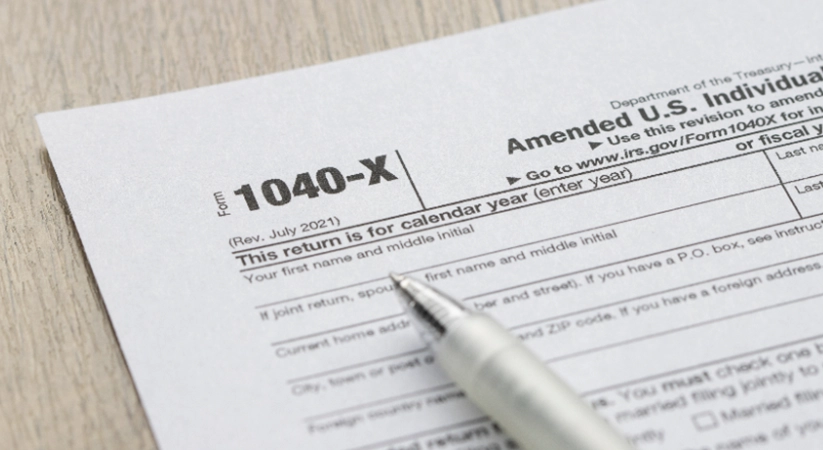
The IRS gives you a mulligan?
What is my amended tax return status?
As a taxpayer, updating or correcting your tax return is sometimes necessary. This is where an amended tax return comes into play. However, once you have submitted your amended tax return, the next question that pops up is, “What is my amended tax return status?”
The status of your federal return is a crucial piece of information that provides you with relevant updates on the processing of your request. Essentially, there are three different amended tax return statuses that you may encounter – received, adjusted, and completed.
If your amended return is marked as received, it means that your file has been received by the Internal Revenue Service (IRS). This essentially means that your amended tax return is being processed, and official work has started on it. The second status that you may encounter is adjusted. If your amended return has been marked as adjusted, it means that the IRS has assessed your request, and the requested change has been made. At this point, you may receive a refund or an additional tax bill based on the adjusted amount in your federal return. Finally, your amended return could be marked as completed.
This means that the IRS has processed your amended return and has provided you with a follow-up response in the form of a tax bill or exact refund amount, which is mailed to you.
To check the status of your amended tax return, you can visit the IRS website and navigate to the Where’s My Amended Return tool. Currently, the tool covers amended returns filed during the current calendar year and the three previous calendar years.
Reasons to File an Amended Tax Return
If you made an error on your original tax return or you need to update it for any other reason, don’t hesitate to file an amended tax return. It can help you avoid headaches and consequences in the long run.
Filing an amended tax return might be necessary if you discover an error after tax filing. Perhaps you forgot to report a source of income, overlooked a deduction or credit, or inadvertently claimed too many dependents. Whatever the reason, correcting mistakes on your tax return is important to ensure you pay the correct amount of taxes owed to the government and avoid any penalties or interest charges.
There are many common situations that might require you to file an amended tax return. For example, changes in filing status, such as getting married or divorced, may impact the amount of taxes you owe. Similarly, if you claimed the wrong number of dependents on your original return, you may need to make changes to the number of exemptions you claimed.
Changes in income, deductions, or credits can also be valid reasons to file an amended tax return. For instance, if you received a bonus after filing your original return, you may owe more taxes or get less than your previous refund. Similarly, if you find that you qualify for a tax credit or deduction you didn’t claim originally, filing an amended return could result in a refund that you would otherwise miss out on. You may also need to file additional forms, including information about social security benefits and making sure any updates to your mailing address and ZIP code are made on the federal form.
It’s important to note that failure to file an amended tax return when necessary could result in hefty penalties and interest charges which will only increase over time. Additionally, if the IRS determines that you underpaid your taxes, you may be subject to audits and other enforcement actions.
Types of Amendments
When it comes to taxes, mistakes can happen. That’s why the IRS has created a process for taxpayers to make changes or corrections to their previously filed returns. These changes are referred to as amendments. In this article, we’ll take a closer look at the different types of amendments you can make and when they may be necessary.
Changes in Filing Status or Dependents Claimed Can Impact the Need to File an Amended Tax Return
Filing your taxes can be confusing and stressful, especially when there are changes in your life that impact your filing status or dependents claimed. These changes can include getting married or divorced, having a child or adopting a child, or becoming responsible for another individual’s care. When these changes occur after you have filed your original tax return, it may be necessary to file an amended tax return.
If you have experienced a change in your filing status or claim for dependents since you filed your original tax return, you may need to file an amended return. For example, if you got married in the previous tax year, you may need to change your filing status from single to married filing jointly or married filing separately. Similarly, if you had a child in the previous tax year, you may be able to claim a dependent, which can impact your tax liability.
When filing an amended return due to a change in filing status or dependents, make sure to include the correct filing status and all eligible dependents. Failing to include the correct information can result in delays in processing your return, potential audits, and even fines or penalties. Therefore, it is important to double-check your amended return before submitting it to the IRS.
Change in Income, Deductions, and Credits Reported on an Amended Tax Return:
Amending a tax return may be required if there are alterations in reported income, deductions, and/or credits from the original return. Variations may occur due to the identification of previously unreported income, the identification of new deductions or credits to claim, or the discovery of errors in previously-reported income or deductions.
For instance, you may realize that you received additional income from freelance work or investments that was not reported on the original return. In such cases, you would need to file an amended return to include this additional income. Similarly, if you recently realized that you are eligible for certain deductions or credits that were not claimed on the original return, filing an amended return becomes necessary.
It is crucial to have proper documentation to support the amended figures on the revised return. This documentation can include receipts, invoices, bank statements as well as any other documents that can provide an accurate reflection of the updated numbers. Failing to provide adequate documentation could lead to further complications from the IRS.
When modifying your tax return, it is crucial to employ the appropriate forms and procedures. If you are revising a prior year’s return, you will require the corresponding year’s tax forms. It is recommended to consult with a tax expert or utilize tax preparation software to guarantee that all forms and instructions are accurately followed.
Math Errors on the Original Tax Return
Math errors on the original tax return are not uncommon. These errors can have a significant impact on the final amount of tax liability or refund claim. To address math errors, the first step is to total all the previously claimed amounts and compare them with the final amount calculated on the your first return. If there is a mismatch between these numbers, it is crucial to obtain the correct figures.
Correcting math errors can be done by attaching schedules or stating the correct amounts on the original tax return. It is important to provide detailed schedules to support the correct figures. This will help the IRS understand the changes and ensure that they are accurately represented.
When Is the Deadline for Amending a Tax Return?
Filing a tax return can be a complex and stressful process, especially if you realize that you’ve made mistakes or omissions on your initial submission. Fortunately, the IRS offers taxpayers the opportunity to correct these errors by filing an amended tax return. However, it’s important to know the deadline for making these corrections to avoid penalties or interest charges. Read on to learn more about when you should file an amended tax return.
IRS Time Limits for Filing an Amended Tax Return
Filing an amended tax return can be necessary to make corrections or claim additional refunds that were missed in the original federal tax return. However, it’s important to ensure that you meet the IRS time limits for filing an amended return to avoid any complications. The IRS typically allows taxpayers to file an amended return within three years of the original filing date or within two years of the date the tax was paid, whichever is later.
It’s important to note that the time limit may differ depending on the state if you’re filing an amendment to claim a refund. Therefore, it’s recommended to check with your state’s tax agency to determine the specific time limit. It’s important to file your amended return by the appropriate deadline to avoid losing out on eligible refunds.
When filing an amended tax return that results in owed taxes, timely payment of the owed amount is crucial to avoid accruing interest and penalties. Failure to pay within the allotted timeframe could lead to wage garnishment or asset seizure, among other financial repercussions.
Common Mistakes When Filing an Amended Tax Return
Filing an amended tax return can be a daunting process for many taxpayers. It’s important to ensure that the amended return is accurate and complete to avoid any further complications down the line. Unfortunately, there are some common mistakes that taxpayers tend to make when filing amended tax returns.
One of the most common mistakes is forgetting to include necessary documents that support the changes made in the amended return, such as W-2s or 1099s. These documents are necessary to establish proof of income and deductions and can help to support any discrepancies or changes made to the original return. Another mistake that taxpayers make is not checking for accuracy when completing the amended return. It is crucial to ensure that all information is entered correctly to avoid further errors or delays in processing. Any discrepancies found in the amended return could trigger an audit or additional scrutiny of the taxpayer’s finances.
In addition to accuracy, it’s important to provide sufficient detail when explaining the reasons for the amended return. Failure to provide enough detail or explanation could lead to confusion or rejection. The IRS needs to understand why changes were made to the return, so providing a clear and concise explanation is essential.

Markos Banos
Markos M. Baños Cabán, Esq., is the Director of Resolutions at Community Tax LLC, where he leads a team of practitioners and service professionals dedicated to resolving complex tax conflicts, including IRS audits, tax liens, and tax debt. A licensed attorney, tax practitioner, and notary public in Puerto Rico, Markos combines his extensive legal expertise and management skills to deliver exceptional results and reduce stress for his clients. He holds a Juris Doctor from the University of Puerto Rico School of Law and has experience in a variety of legal fields, as well as industrial management. Bilingual in English and Spanish, Markos is also a published researcher with a passion for delivering outstanding service.







